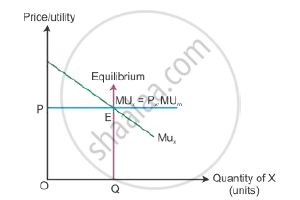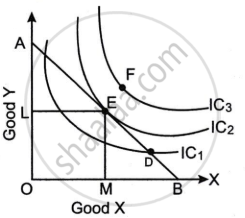Advertisements
Advertisements
Questions
Given the price of a good, how does a consumer decide as to how much of the good to buy?
Given the price of a good, how will a consumer decide as to how much quantity to buy of that good? Explain.
Given the price of a good, how will a consumer decide as to how much quantity of that good to buy? Use utility analysis.
Solution
Given the price of the good, a consumer will decide the amount of goods to buy. So, the consumer compares the price of the good with its utility. A rational consumer will be at equilibrium only when the marginal utility is equal to the price paid for the good.
MUX = PX
The marginal utility is greater than the price paid for the good, i.e. MUX > PX implies that the consumer is not in equilibrium and buys more of a good. While the marginal utility is lesser than the price paid for the good, i.e. MUX < PX implies that the consumer is not in equilibrium and buys less of that good.

In the diagram, OP is the price of the good given on the Y-axis and OQ is the utility given on the X-axis. The marginal utility curve MUX slopes downwards because the marginal utility
diminishes with every additional consumption of X. The consumer reaches equilibrium at Point E, where the marginal utility is equal to the price paid for the good
APPEARS IN
RELATED QUESTIONS
A Consumer consumes only two goods X and Y. Marginal utilities of X and Y is 4 and 5 respectively. The prices of X and Y are Rs 4 per unit and Rs 5 per unit respectively. Is the consumer in equilibrium? What will be the further reaction of the consumer? Explain.
A consumer consumes only two goods A and B and is in equilibrium. Show that when price of good B falls, demand for B rises. Answer this question with the help of utility analysis
A consumer consumes only two goods X and Y. If marginal utilities of X and Y are 4 and 5 respectively, and if price of X is Rs 5 per unit and that of Y is Rs 4 per unit is the consumer in equilibrium? What will be further reaction of the consumer? Explain.
A consumer consumes only two goods X and Y both priced at Rs 3 per unit. If the consumer chooses a combination of these two goods with Marginal Rate of Substitution equal to 3, is the consumer in equilibrium? Give reasons. What will a rational consumer do in this situation? Explain
A consumer consumes only two goods X and Y whose prices are Rs 4 and Rs 5 per unit respectively. If the consumer chooses a combination of the two goods with marginal utility of X equal to 5 and that of Y equal to 4, is the consumer in equilibrium? Give reason. What will a rational consumer do in this situation? Use utility analysis.
A consumer consumes only two goods X and Y, both priced at Rs 2 per unit. If the consumer chooses a combination of the two goods with Marginal Rate of Substitution equal to 2, is the consumer in equilibrium? Why or why not? What will a rational consumer do in this situation? Explain.
A consumer consumes only two goods X and Y whose prices are Rs 5 and Rs 4 respectively. If the consumer chooses a combination of the two goods with marginal utility of X equal to 4 and that of Y equal to 5, is the consumer in equilibrium? Why or why not? What will a rational consumer do in this situation? Use utility analysis
A consumer consumes only two goods, each priced at Rupee one per unit. If the consumer chooses a combination of the two goods with Marginal Rate of Substitution equal to 2, is the consumer in equilibrium? Give reasons. Explain what will a rational consumer do in this situation.
A consumer consumes only two goods X and Y whose prices are Rs 2 and Rs 1 per unit respectively. It the consumer chooses a combination of the two goods with marginal utility of X being 4 and that of Y also being 4, is the consumer in equilibrium ?Give reasons. Explain what will a rational consumer do in this situation. Use Marginal Utility Analysis.
If equilibrium price of a good is greater than its market price, explain all the changes that will take place in the market. Use diagram.
Market for a good is in equilibrium. There is simultaneous “decrease” both in demand and supply but there is no change in market price. Explain with the help of a schedule how it is possible.
From the following schedule find out the level of output at which the producer is in equilibrium, using marginal cost and marginal revenue approach. Give reasons for your answer.
|
Price per unit (Rs) |
Output (Units) |
Total Cost (Rs) |
|
8 |
1 |
6 |
|
7 |
2 |
11 |
|
6 |
3 |
15 |
|
5 |
4 |
18 |
|
4 |
5 |
23 |
Identify the correctly matched pair from Column A to that of Column B:
| Column A | Column B | ||
| (1) | Investment Multiplier | (a) | C + I + G + (X − M) |
| (2) | Marginal Propensity to Consume | (b) | `(ΔC)/(ΔY)` |
| (3) | Marginal Propensity to Save | (c) | `(ΔI)/(ΔY)` |
| (4) | Aggregate Demand | (d) | `(ΔS)/(ΔY)` |
Refer to the diagram given below and answer the questions that follow.

- What does the line AB represent? Why is the line AB negatively sloped? (2)
- At which one of the given points, D, E and F, will the consumer attain equilibrium? Explain. (2)
- Briefly explain why the consumer is not in equilibrium at the other two points. (2)
